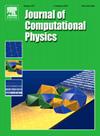Diffuse-interface modeling and energy-stable numerical framework for the heat transfer-coupled two-phase fluids in contact with solids
IF 3.8
2区 物理与天体物理
Q2 COMPUTER SCIENCE, INTERDISCIPLINARY APPLICATIONS
引用次数: 0
Abstract
To efficiently simulate the heat transfer-coupled two-phase fluid flows with wetting condition in irregular domains, we develop a diffuse-interface heat fluid system. A traditional ternary Cahn–Hilliard model is modified to approximate the damping of solid on fluid. Based on equilibrium interface assumption and Young's equality, an extra term reflecting wetting contact line is derived and added into the diffuse-interface model. The heat transfer and fluid dynamics are described by coupling the penalized incompressible Navier–Stokes equations and a diffusion conduction equation with variable coefficients. The proposed model can efficiently describe complex heat fluid flows in contact with solids because the computations are implemented in regular rectangular domains. The complex techniques for the treatment of fluid-solid boundary are not necessary. Moreover, the proposed model also leads to an energy dissipation law. To satisfy this basic physical property in simulation, we propose linear, totally decoupled, and second-order energy-stable scheme to update the solutions. The time-discretized energy law is analytically estimated. In each time step, the solutions can be easily obtained by solving several linear elliptic-type equations in a step-by-step manner. Extensive numerical experiments in two- and three-dimensional spaces are implemented to validate the accuracy and stability of our method. These results also indicate that the proposed method has good potential in simulating complex fluid flows with heat transfer.
求助全文
约1分钟内获得全文
求助全文
来源期刊

Journal of Computational Physics
物理-计算机:跨学科应用
CiteScore
7.60
自引率
14.60%
发文量
763
审稿时长
5.8 months
期刊介绍:
Journal of Computational Physics thoroughly treats the computational aspects of physical problems, presenting techniques for the numerical solution of mathematical equations arising in all areas of physics. The journal seeks to emphasize methods that cross disciplinary boundaries.
The Journal of Computational Physics also publishes short notes of 4 pages or less (including figures, tables, and references but excluding title pages). Letters to the Editor commenting on articles already published in this Journal will also be considered. Neither notes nor letters should have an abstract.
 求助内容:
求助内容: 应助结果提醒方式:
应助结果提醒方式:


